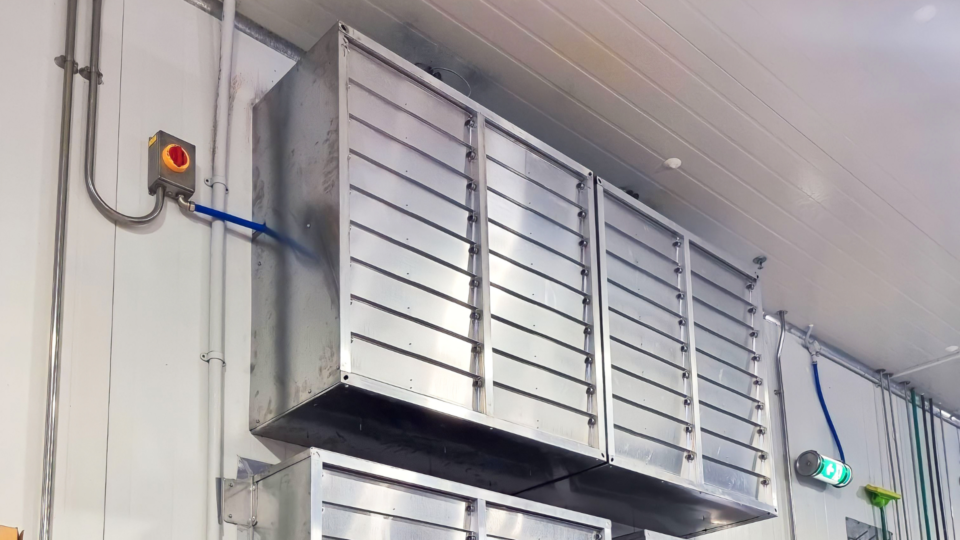Ventilation is a health and safety requirement for many industries, including mining, metals, food production, and manufacturing. When choosing the right equipment, the options are endless with the Australian ventilation market size at $569.4 million in 2021.
How do you make the right choice for your company?
Choosing the right ventilation system requires knowledge of the products and understanding the best features for your facility’s specifications. Exhaust fans are a common feature in many ventilation solutions, but there are varieties best suited to different applications. Keep reading as we explore the differences between wall plates, end walls, and side wall fans for your exhaust ventilation.
Benefits of investing in an exhaust fan
Why do you need an exhaust fan? Exhaust fans do just that; exhaust. They remove contaminated, hot or dusty air out of the area, making room for new, fresh air to circulate in. Ever been in a hot room where the fans feel like they’re only blowing hot air around? That’s an example of a space that has air circulation, but not enough air extraction.
Here’s what an exhaust fan provides for your ventilation strategy:
- Improving air quality – installing an exhaust fan will help remove any pollutants, fumes, or airborne particles affecting the air quality. The fan will remove these contaminants from the air to maintain a safe and healthy work environment. By exchanging indoor and outdoor air regularly with a steady air exchange rate, the fan will remove harmful substances from the air to improve air quality.
- Temperature control – exhaust fans help promote air circulation, improving temperature control within your facility. Even with high-quality heating and cooling systems, your facility can suffer from temperature stratification, where the heat rises and cold air sinks. Stratifications means you won’t get ROI on what you invest in heating or cooling, which is why exhaust fans are so beneficial, regulating the temperature with destratification.
- Humidity control – when humidity isn’t regulated, you can suffer from dampness and mould growth. Exhaust fans expel the excess moisture in the air, providing more humidity control and reducing the likelihood of rust, mould, and dampness in your facility.
- Odour elimination – in industrial environments, the air can be thick with heavy burning, food, or chemical odours that create an unpleasant working environment. Exhaust fans expel these odours from the indoor air and create a more pleasant atmosphere without pungent byproducts.
- Dust and particulate removal – managing debris from manufacturing and industrial processes protects workers’ lungs. Exhaust fans extract these particulates, ensuring adherence to air quality and health and safety protocols.
- Preventing combustion – mining and manufacturing processes can cause combustible gases and materials to be emitted. Proper exhaustion helps prevent fire hazards and risks to human life on site.
Exhaust fans are integral to safe and pleasant working environments across many industries.
Types of exhaust fan
You must choose a type of exhaust fan before installing one in your facility. Here are the different types and what they’re best suited for.
Side wall exhaust fan
A side wall exhaust fan fits the side wall of your building, allowing it to expel air directly outside in a horizontal direction. This type of exhaust fan is ideal for facilities lacking suitable roofing structures for roof fan installation. They have a streamlined design perfect for facilities with structural constraints and space limitations.
Here are some of the additional advantages on offer with a side wall exhaust fan:
- Localised ventilation – a side wall exhaust fan provides targeted airflow to remove heat, humidity, fumes, and contaminants from specific areas containing equipment.
- Space saving – without using your roof space for ventilation, you can install more important fixtures such as solar panels.

End wall exhaust fan
An end wall exhaust fan is installed on a building’s end wall, allowing for specific advantages due to their design and installation placement, such as:
- Efficient airflow – by creating a direct path for airflow movement, an end wall exhaust fan maximises the efficiency of your ventilation system. They support rapid air exchange rates without increasing your energy bills.
- Space utilisation – if you don’t have any available roof space, this fan type will be the most suitable for your facility.
- Specific air quality control – an end wall exhaust fan provides localised air quality management, reducing fumes and heat produced in particular areas within your facility.

Wall plate exhaust fan
A wall plate exhaust fan is typically installed using a plate or mount. It provides the following advantages for your industrial ventilation strategy:
- Easy installation – with a convenient wall plate, this fan provides straightforward installation for any wall in your facility. The design is self-contained, and they are an ideal choice for facilities that need to install their ventilation quickly.
- Localised ventilation – a wall plate exhaust fan can provide airflow and extraction for specific areas to preserve air quality and keep equipment cool.
- Cost-effective – the wall plate exhaust fan doesn’t need complex ductwork, making the installation costs much lower.
- Space efficiency – the simple infrastructure, along with the reduced need for ductwork, make wall plate fans ideal for saving space.

Choose Fanquip for exhaust solutions suitable for all industries
All exhaust fans serve the same essential purpose – they help mitigate fumes, contaminants, and combustible components. They keep workers safe and make the air clean, pleasant, and breathable.
Choosing the right exhaust fan can be tricky – which is why you need the help of ventilation experts. Call us at Fanquip to access our team’s expertise and plan your ventilation strategy per your facility’s specifications.
